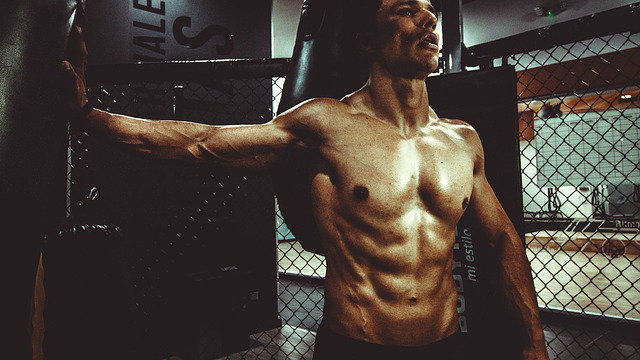 Reading Time: 8 minutes
Reading Time: 8 minutesI was once measured at 3.8% bodyfat in a Bod Pod. The test administrator told me he had only taken one other measurement that was lower than mine — and that person was a professional athlete.
But I wasn’t a professional athlete, just a regular Joe, fitness junkie, and martial artist. I wasn’t a competitive boxer cutting weight for a fight and I wasn’t even trying to be a certain percentage of body fat.
No, I was desperately trying to achieve something I couldn’t quite define or put my finger on. I was grasping for an unattainable ideal of perfection and consumed with the energy of wanting more and more — a faster, leaner, more defined body.
My Personal Struggle with Body Image
That body fat measurement was a low point for me both literally and figuratively. Instead of feeling I had reached the pinnacle of perfection in bringing my shredded body to it’s lowest body fat possible, I felt shredded in a different way — emaciated and broken down.
I was often agitated and worn thin. People had been making comments to me for several months along the lines of, “You’re too skinny,” and “You look sick.” My father had noticed how much running I’d been doing and asked me point blank what I was running from.
Thankfully, being informed of my frighteningly low body-fat percentage was a wake-up call and a tipping point. Seeing that number made me realize how extreme I had become in appearance and in my habitual exercise patterns. My body was 25 pounds lighter than my historical weight and I was barely above what is considered the essential level of body fat.
Too low of a body fat percentage is correlated to everything from suppressed immunity to skin problems to negative mood. Not to mention going below 3% body fat is correlated with death! I was dangerously low without a good reason to be there. If I were to get sick, I might not have any margin for error and the consequences could be dire.
I knew it was time for a change, so I started the arduous journey toward finding balance and my natural physique. While putting weight back on might sound like a good problem, the real work was about getting my mind right.
Whether you’re frantically trying to lose or gain weight, the challenge isn’t about finding right the number on the scale or percentage of body fat. The real challenge is about finding something much more valuable than the perfect body — peace of mind.
You Are Not Alone
If you’ve struggled with body issues, disordered eating, exercise addiction, or just being generally dissatisfied with your appearance, you are not alone. The statistics are downright shocking — more than 90% of girls ages fifteen to seventeen want to change at least one aspect of their appearance with body weight leading the way. Glamour Magazine suggests that 97% of women have at least one negative body image thought each day, and women on average have thirteen negative thoughts per day.
And what was historically thought of as a female issue has now been affecting men in increasing and alarming numbers. A Yahoo article recently reported:
“America is in the midst of a cultural shift in terms of the ideal male body image, and as the ideal man grows more muscular, men stuck in the real world with real bodies are growing less satisfied with theirs — with potentially dangerous medical consequences.”
Statistics corroborate this notion. It was previously thought that a very small percentage of eating disorders occurred in men, but new evidence suggest that men may account for as much as 25% (or higher) of those dealing with certain prevalent eating disorders. Furthermore, a new article in the Journal of American Medical Association concluded that when it comes to steroid use, “Most young men using these drugs are doing it to improve their appearance.”
Also alarming is that 18% of boys reported they are concerned about their weight and/or physique. The study concluded that such anxiety leads to an increase in depression and high-risk behaviors such as drug use.
How to Know if You Have a Problem
Whether young or old, male or female, too thick or too thin, body image is something that many of us struggle with at some point. Here are the important questions to ask yourself to determine the depth of a potential body image issue, as well as suggestions on how you can find your way out of the destructive cycle of negativity and obsession:
- Can you take a break? Training hard is a good thing and even when you’re on vacation or stressed, exercise should still be a part of your daily routine. That said, rest is of equal importance and if you can’t ease up without going into a tailspin, it may be a sign you’re overtraining or even battling addiction. Try taking two consecutive days off and if you find yourself agitated, moody, or grumpy, you may need to evaluate the role exercise plays in your life.
- Are your dietary restrictions ruining the party? It’s common courtesy to ask if there are any dietary restrictions when having someone over to dinner. But such an inquiry is typically intended to be about food allergies and/or sensitivities, not an open invitation for you to delve into your nutritional hang-ups. If you can’t go to dinner with friends or be a guest at someone’s house without your eating habits being a major production, odds are your relationship with food (and/or your body) needs further investigating.
- Does your fitness require a superhuman effort? Back when I hovered below 4% body fat, I commuted to work via bike, and I ran, boxed, and lifted daily. I worked out on average twice a day, every day. Such a heavy training volume took a toll as I frequently wound up injured and run down. If you’re in a routine that isn’t sustainable, then your body shape and size likely isn’t sustainable either.
- Are your work habits or relationships hampered by your fixation with your body or exercise? It takes a lot of work (and time) to obsessively maintain an unnatural physique. One of the ways to determine whether you are obsessive and/or out of balance is to simply listen. Sometimes those closest to us like family, friends, and coworkers will flat out tell us when we’re off track — if we can hear them. When we’re in the throws of mania, it can be difficult to see or hear clearly, but odds are that those close to you can. Listen to them. Ultimately, if your body is getting in the way of your job and/or relationships, it’s time to step back and reprioritize.
What to Do if You’re Struggling
Determine your natural body type and stay true to it.
Think about a dog breed and how silly it would be for a Rottweiler to try to look like a Jack Russell terrier. Yet that is what many humans try to do. We want to be something we’re not — a different “breed” — instead of nourishing and enjoying what we are. Everyone has a natural body type. Your job is to find and appreciate yours.
Focus on how you feel rather than how you look.
It’s important to remember the definitions of fitness and wellness are not aesthetic but qualitative. Fitness is a state of functionality and wellness is a state of health. Focusing on how you look is limited by the laws of aging and physics whereas focusing on how you feel is limited only by your attitude and how you care for yourself.
Get support.
Support is an important component in success with just about anything, but finding the right support can be tricky. When you’re struggling with body issues or exercise addiction, sometimes the gym culture that fuels that addiction can hinder your success rather than help. It’s great to have a workout buddy, but make sure your “support” mechanisms appreciate who you are, not what you look like.
Surrender.
All material organisms share the life cycle of introduction, growth, decline, and maturity. Each cycle offers opportunity for real growth in wisdom, satisfaction, and joy. But the only way find that genuine state of happiness is to be present through each stage. It starts with surrender to the present moment, which means accepting your body in the place where it is. While the desire for improvement and change are worthy endeavors, sustainable progress has everything to do with the ability to be where you are and enjoy the ride.
Seek professional help.
Eating disorders and addiction of any kind are no joke. Sometimes even with a good plan and the right support, success doesn’t come easily. If you are in failing health or in a habitual self-destructive pattern, you should seek professional health. There are a lot of great support groups out there, as well as trained medical professionals equipped to get you back on the right track.
Accept Your Self and Your Body
Finding peace with your body isn’t a destination. Like all concepts of health and well-being, whether physical or mental, self-acceptance is a process.
Bodies are material organisms and even if you happen to be blessed with an attractive and athletic one, the only certainty is that your physique will change through the natural process of decay and aging. So, in the end, the best path to physical and mental health is to consider that looking your best should be synonymous with feeling your best.














